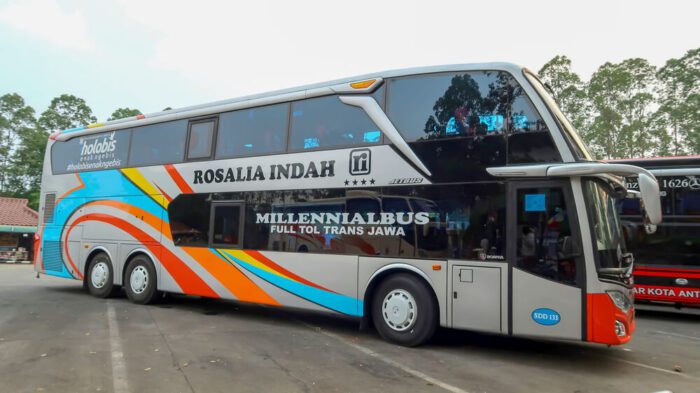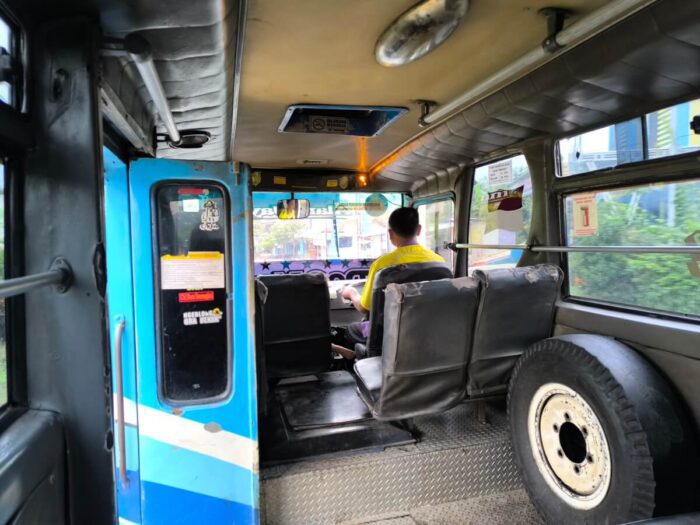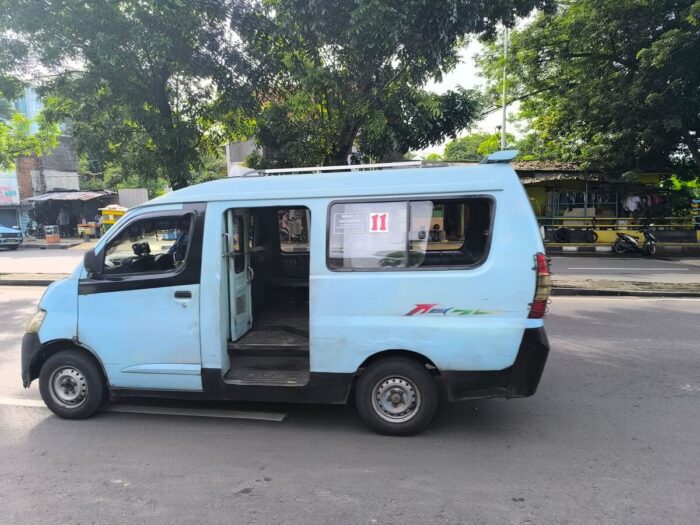Traveling by bus in Java is not just a way to get from A to B — it’s a real window into local life. Affordable, adventurous, and sometimes chaotic, buses connect you to places no train can reach and offer a true slice of Indonesia on the move.
The cheaper the bus, the more adventurous your journey will be. Speaking from experience — after more than 8 years of living, traveling, and occasionally sprinting after buses I missed — I can tell you that a little preparation never hurts. That’s why I’m sharing my best tips for traveling around the island by bus.
Types of Buses in Java
Bus travel in Java comes in many forms. At the most basic level, you have economy buses — old, crowded, and without air-conditioning. They’re a raw and budget-friendly way to experience local life.
Step up a little and you’ll find standard buses with AC and more comfortable seating, ideal for medium-length trips.

For longer journeys, Executive and Super Executive classes are a much better choice, with spacious reclining seats, strong air-conditioning, snacks, and sometimes even personal entertainment screens.
Overnight buses are common for longer distances, allowing you to save time and money by traveling while you sleep (or at least try to).
And if you want the ultimate comfort, some companies even offer sleeper buses with fully reclining seats or private pods, offering maximum comfort on Java’s busy roads.

Major Bus Companies to Know
Java’s bus network is huge, but a few companies stand out:
Rosalia Indah and Sinar Jaya are among the most trusted names for long-distance routes. Lorena and Pahala Kencana offer extensive networks connecting not just cities across Java but also reaching Sumatra and Bali. DAMRI, the state-owned bus company, operates many city and intercity routes.
Juragan 99 is a comfortable and luxurious bus option, offering sleeper buses for those traveling to East Java or Bali.
Backindo Tip: DAMRI also runs in popular tourist destinations like Yogyakarta–Borobudur, Banyuwangi–Ijen Crater, or Surabaya–Bromo. For these routes, they usually use a Hiace van, and tickets cost around 15,000–30,000 IDR.
Whichever company you choose, if you’re traveling long distance, it’s worth paying a little more for Executive Class or higher — your body will thank you after hours on the road.
Booking Tickets: How and Where
Booking a bus ticket in Java is pretty straightforward. You can use apps like Traveloka, tiket.com or 12go, where you can compare operators, check seat layouts, and even choose your preferred seat in advance. You can also select which terminal to depart from, as larger cities usually have multiple bus stations. This flexibility is especially helpful for overnight buses, which tend to leave from the outskirts of the city.
Keep in mind that after booking online, you might still need to show a voucher or booking code — both at the ticket booth and again when boarding the bus.
Another option is to buy your ticket directly at the terminal. Just be prepared for a bit of organized chaos: ticket counters can be confusing, and you’ll need patience — along with a few smiles and some cash — to make your way through. Signage is often limited, and the environment can be loud and hectic.
You’ll likely be approached by “helpers” offering to guide you to your bus. Some are genuinely helpful; others are unofficial agents working for specific companies. If you know which company you’re looking for, it’s much easier to get pointed in the right direction. These helpers usually expect a small tip of IDR 5,000–10,000 for their assistance.
To be honest, trains are the best way to get around the island. Read more in How to Travel by Train in Indonesia.
What to Expect During Your Journey
Most long-distance buses in Java offer a small snack and a drink at the beginning of the trip. Buses typically make a planned meal stop halfway, where you can stretch your legs and grab a bite to eat. Sometimes the ticket includes a meal voucher; other times, you’ll need to pay separately.
When you get off at a rest stop, it’s smart to take a photo of your bus and its license plate. Buses often move or park somewhere else after passengers disembark, and finding your specific bus among dozens of identical ones isn’t always easy.

Larger buses usually have onboard toilets, but they are basic and intended mainly for emergencies. It’s better to use restroom facilities at the meal stops whenever you can. Note that public toilets usually charge a small fee — around IDR 2,000 (about 10–15 cents) — so make sure to carry small change.
Drivers can vary greatly: some are cautious and steady, while others seem to think they’re competing in a Formula 1 race. Particularly with cheaper bus companies, expect frequent honking, sharp overtaking, and minimal rest breaks.
If you’re traveling with kids or have a sensitive stomach, it’s worth spending a bit more and maybe reconsider those super-budget options.
Backindo Tip: Traveling by bus in Java is generally safe, even for solo female travelers (I did it manytime). Just follow basic precautions like keeping an eye on your belongings and choosing official terminals whenever possible.
Vendors inside Buses
During stops, or just after the bus starts moving again, don’t be surprised if local vendors hop onboard. It’s completely normal. They often place snacks, toys, or small gadgets on each seat without asking. If you don’t want to buy anything, simply leave the item untouched. The vendor will walk back down the aisle later and collect everything.
If you do wish to buy something, prices are usually written on the packaging, and you can just hand over the money when they pass by.
You might also encounter musicians — usually solo singers with guitars — who perform a few songs and then walk through the bus asking for tips. If you’re not interested, a polite smile and a small shake of your head is enough. No one will pressure you to give anything.

Buses for Shorter Trips
For smaller towns and more rural areas, minibuses like angkot (in Central and West Java) or bemo (in East Java) rule the roads. They don’t run on a fixed schedule, stop whenever someone waves along their route, and are very budget-friendly. Tap on the ceiling or say “kiri,” meaning “left,” when you want to get off, and pay the driver as you exit.

One of the most famous routes for travelers is the bemo from Probolinggo to Cemoro Lawang, the jump-off point for visiting Mount Bromo. These bemos wait until they are full before departing, or you can pay extra to leave sooner.
Popular Bus Routes in Java: Where Trains Don’t Reach
While Java’s train network is fantastic for many routes, there are plenty of incredible places where the railway just doesn’t go — and that’s where buses (and a bit of patience) come to the rescue.
Some popular bus routes worth considering:
- Jakarta – Pangandaran: Pangandaran, with its relaxed beaches and beautiful Green Canyon, isn’t served by train. Although negotiations are underway to extend the line, as of early 2025, the closest train station remains about two hours away. Buses leave from Kampung Rambutan or Kalideres terminals and usually take around 8–10 hours, depending on traffic.
- Malang – Tumpak Sewu Waterfall: One of Java’s most stunning natural sights, Tumpak Sewu, is tricky to reach. You’ll need to take a bus towards Lumajang from Malang, then arrange a local ride (ojek or small van) for the final leg. It’s a real adventure — but absolutely worth it.
- Surabaya – Banyuwangi: Although a train runs on this route, many travelers prefer buses for their flexibility, especially when heading to the ferry terminals for Bali crossings. Executive night buses are a popular and comfortable choice here.
- Yogyakarta – Dieng Plateau: Dieng is a magical highland full of temples and colorful volcanic lakes. While there’s no direct train service, buses connect Yogyakarta to Wonosobo, from where you can catch a minibus up into the plateau.
We have dozens of guides covering specific areas of Java, including hidden gems. Simply browse individual categories like West Java, Jakarta, Central Java, Yogyakarta, and East Java — and start exploring.
After You Get Off the Bus: What to Expect
Stepping off the bus can sometimes feel just as chaotic as getting on. In many bus terminals, you’ll immediately be approached by ojek drivers (motorbike taxis) offering to take you somewhere — sometimes a little too eagerly. It’s best to step aside for a moment, gather your bearings, and politely decline if you don’t need their help. A simple smile and a “no thank you” or a small shake of the head is enough.
If you’re planning to use Gojek or Grab, be aware that in some terminals, app-based pickups are not allowed directly at the terminal gate. You might need to walk a few minutes outside the terminal area to meet your driver.
Luckily, the apps make this pretty easy: when you request a ride, official pick-up points will appear on the map. If you don’t see any nearby, and the nearest point looks a little farther away, it means you’ll need to exit the terminal and walk there.
Backindo Final Tip: Enjoy the Ride
Bus travel in Java might test your patience sometimes, but with an open mind and a sense of adventure, it often becomes one of the best stories you’ll bring home. Plan a little, stay flexible, and let the journey become part of the magic.
Read more:
